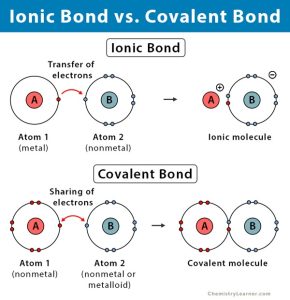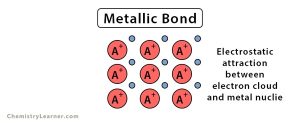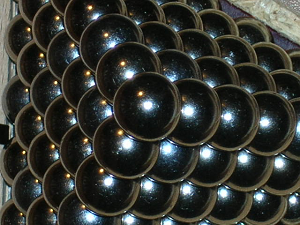Metallic Bond
In this article, we aim to discuss metals and their properties. We will learn the definition of metallic bonding and understand the characteristics of metallic bonds, including the strength of metallic bonds. The content of this article will help us gain a proper understanding of the properties of metals, such as conductivity (electricity and heat transfer), malleability and ductility, strength, and more.

Definitions
If you are familiar with covalent and ionic bonds, you know that these bonds form between two atoms. When two atoms share their electrons, they form a covalent bond. When one atom removes an electron from another, and the resulting positive and negative ions are attracted to each other, the atoms have formed an ionic bond.

A metallic bond differs greatly from covalent and ionic bonds, but the goal is the same: achieving a lower energy state. In metallic bonding, instead of a bond between two atoms, electrons are shared among many atoms of a metallic element.
Look around you and find a metal piece. This small metal piece, like a pool full of water, contains a large reservoir of valence electrons, known as a sea of free electrons or non-localized electrons.

Shape 2: Metallic Bond
To better understand metallic bonding, imagine that you have filled your bathtub completely with solid metal spheres from bottom to top. As these spheres fill the tub, they form an orderly arrangement. Do you notice any spaces between the spheres? Now, if you open the tap and close the drain pipe, water will fill those spaces. What you’re now observing is something similar to a metallic bond. In fact, these spheres represent metal atoms, and the water symbolizes the valence electrons that are shared between all the atoms.

Figure 3: Solid metal spheres arranged together in an orderly fashion.
When the valence electrons of atoms detach from their original atoms and become free-floating in space, these atoms turn into positive ions. As a result, a regular structure of positively charged metal atoms is formed, surrounded by a sea of negative electrons, which hold the ions together like glue.
Simply put, metallic bonding is the process by which metal atoms come together in a metallic substance. Metallic bonding is a type of chemical bond similar to covalent bonding. Metal atoms are held together by forces arising from their valence electrons. The valence electron is the electron found in the outermost energy level of an atom. Due to the nature of metal atoms, the valence electrons do not have a strong bond with the atom’s nucleus. This property allows valence electrons to become delocalized or move away from the original atom. Metals have atoms that are closely packed together. As these valence electrons detach from their original atoms, they move from one nucleus to another, forming a “cloud” of free or delocalized electrons in the metal. Since the electrons have left the nuclei of the original atoms, there are more protons than electrons left in these nuclei. This results in the atoms becoming positive ions. The forces between the positive nuclei and the sea of delocalized valence electrons create a cohesive force that holds the metal atoms together in a unique manner, giving the metal its characteristic properties. According to the definition of metallic bonding, this type of chemical bond only exists in metallic materials.
How does metallic bonding form?
To describe the process of metallic bonding, the concept of a sea or cloud of electrons is used to help visualize the localization of electrons. The valence electrons of metals have a weak bond with their nuclei because they are surrounded by higher energy levels of other electrons. In other words, the valence electrons in a metallic bond can be associated with any atom in the metallic sample. This situation, along with the network arrangement and the closely packed atom pattern, allows the valence electrons to roam freely, detached from a specific parent atom and its associated nucleus. This sea or cloud of electrons carries a collective negative charge and is electrically attracted to the positively charged nuclei, resulting in an overall cohesive or covering force that holds the atoms together.

Properties of Metals
The presence of metallic bonds is a significant factor that imparts special and unique properties to metals. Metals behave in distinct ways and have typical appearances. Some of the characteristics of metallic bonds include: strength, malleability, ductility, thermal and electrical conductivity, and more.
Conclusion
In this article, we introduced ionic and covalent bonds. We then explained metallic bonding and how it forms. We learned that electrons are shared between many atoms of a metallic element, and this results in the metal acquiring its unique properties.
